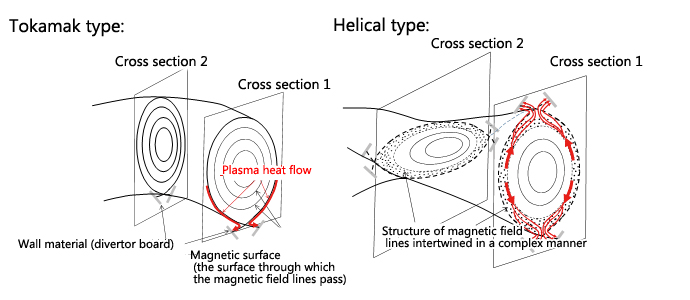HOME > Research Activities > Research Updates >
Plasma cannot freely move vertically in the magnetic field lines, but plasma have the quality of moving extremely fast along the magnetic field lines. In magnetic field confinement devices beginning with the Large Helical Device (LHD), using such qualities of plasma we conduct research in confinement by releasing high-temperature plasma from the wall. Conversely, of nearly equal importance to confining high-temperature plasma is, by lowering the temperature of heat escaping from the plasma, stretching that heat as equally and broadly as possible across the wall and avoiding heat damage to the wall material. Moreover, it also is important to prevent to the extent possible impurities that emerge from the wall from entering the plasma. In this control of the peripheral area, too, the magnetic field lines perform important roles. Here, we will introduce research that controls the plasma-wall interaction by forcing changes in the structure of the magnetic field lines in the peripheral area that surround the plasma.
In a magnetic field confinement device called a tokamak we confine plasma through innumerable magnetic field lines that are shaped similar to a doughnut configuration. Then, regardless of where we cut the doughnut configuration, the cross-sections of the magnetic field lines structure that appear are uniformly the same, like Kintarō candy. In this situation, because plasma has the quality of moving extremely fast on magnetic field lines, if it follows on the same magnetic field line, even plasma in a distant and separated place will join together and their temperature and pressure will easily become the same. This type of tokamak magnetic field configuration does not become a problem in the core plasma. But in peripheral area plasma, because hot plasma that emerged from the core area arrives at the wall at the temperature at which it followed the magnetic field lines, it is projected that the heat damage to the wall will become too great. For that reason, this is an important research issue when considering the future fusion energy power plant.
In contrast, in a helical device such as the LHD, the structure of the magnetic field lines in the peripheral area and the surface condition change depending upon the place where the doughnut is cut. Compared to a tokamak, the magnetic field lines structure is complicated. However, in contrast, because we can freely change the shape and the length of the magnetic field lines, this is beneficial for controlling peripheral plasma. In the structure of the magnetic field in the peripheral area of the helical device, because magnetic field lines that are next to one another are intertwined in a complex manner it has become clear in recent research using the LHD that plasma straddle magnetic field lines and easily cause interaction. When there is such interaction, even if plasma is following the same magnetic field line, dispersion of the heat load becomes possible because qualities of the plasma, such as temperature and pressure, gradually change as the plasma moves further away.
At present, gathering data not only from the LHD but also from other helical devices around the world that have the helical magnetic field configuration, we are investigating those qualities of plasma. As a result, we have learned the following:
1. It is often difficult for impurities from the wall to enter plasmas. Because peripheral magnetic field lines are intertwined in a complex manner, an image emerges in which multiple layers of magnetic field lines wrap around the plasma and block impurities from entering the plasma.
2. By attaching here and there to various walls, heat can avoid concentrating in one place.
3. By changing the shape of the peripheral magnetic field lines, it becomes possible to more steadily maintain peripheral plasma. As a result, we can sufficiently lower the temperature of peripheral plasma and avoid damage to the wall material.
The helical type, compared to the tokamak, has engineering difficulties that derive from the device’s complicated structure. But the helical type has the merit of being able to freely change the shape of the magnetic field lines. We can say that in the future, by advancing further engineering technologies relating to the superconducting coils and the vacuum vessel, and, further, by advancing our understanding of the complex interaction between the magnetic field lines structure and the plasma, the helical type will be able to demonstrate the great superiority of the design of the future fusion power energy plant.
 |
|---|
Schematic diagram of the structure of magnetic field lines in the Tokamak type (left image) and in the Helical type (right image) |
Several cross sections of doughnut magnetic configurations, which are formed by magnetic field lines, are shown. Those cross sections appear as tree rings. The tokamak type appears the same in all of the surfaces, including, too, the peripheral areas, and the heat flow concentrates easily toward the wall material. On the other hand, in the helical type the surface configuration differs depending upon the position. Further, beautiful tree rings cannot be seen because the magnetic field lines in peripheral areas are intertwined in a complex manner. Thus, heat flow moves easily to the next magnetic field line, and the heat flow toward the wall material can be dispersed. |
